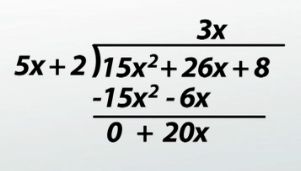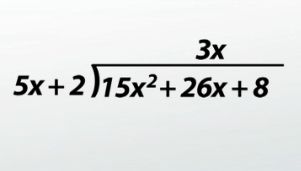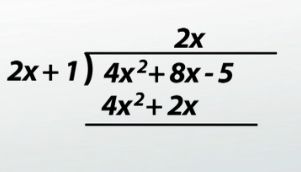How to Divide Polynomials with Long Division
After you watch the video and know the material, click HERE for the quiz.
Arithmetic long division and polynomial long division are very similar. Yes, it's a long process, but once you have the rhythm you will get every problem correct!
Polynomial Long Division
Polynomial long division is very similar to the long division we did as kids, except now we have numbers and xs. It takes only two steps that are repeated until you're done.
- Divide the first terms.
- Multiply the result from the divisor, then subtract it from the dividend.
- Repeat!
Let's review the parts of a division problem. We have the divisor divided into the dividend, and of course our answer is the quotient.
Example #1
Here's our first example: (x^2 + 7x + 12) / (x + 3).
To fill in our long division, x^2 + 7x + 12 is the dividend, so it goes under the long division symbol. x+3 is the divisor, so it goes to the outside, in front of the long division symbol. Now we're ready to start the division. The steps are the same every time. It's easier to show and talk about the steps than listing them, so let's take a look. To find the first term of the quotient, we take the first terms from the divisor and the dividend and divide them. I like to write them as a fraction; it's easier to divide or reduce: x^2 / x = x. x is the first term of the quotient; we write it above the long division symbol. To figure out what we will subtract from the dividend, we multiply x times the divisor, x+3: x(x+3) = x^2 + 3x. x^2 + 3x is written under the dividend, matching like terms. Here's where I like to make life easy. To subtract the polynomials, I simply change their signs and add! So x^2 -x^2 = 0, and 7x - 3x = 4x. Just like we did in long division, we bring down the next term, which is 12.
 |
Guess what? We do the exact same step! To find the next term of the quotient, we take the new first terms and divide them, so we'll have 4x / x. I like to write them as a fraction; it's easier: 4x / x = 4. 4, or positive 4, is the next term of the quotient. Remember, that gets written next to the x above the long division symbol. To figure out what we will subtract from the dividend, we multiply 4 times the divisor, (x + 3). (4)(x + 3) = 4x + 12. 4x + 12 is written under the dividend, matching like terms. Next, I like to change the signs and add down: 4x + 12 - 4x - 12 = 0. It turns out our remainder is zero. What does our answer look like? Just look above the division symbol: x + 4. Are you thinking to yourself 'That wasn't too bad'? Let's try one a little longer. Don't panic. Follow the exact same steps, repeat and we'll have an answer.
 |
Example #2
Divide (15x^2 + 26x + 8) / (5x + 2).
 |
To fill in our long division, 15x^2 + 26x + 8 is in the dividend, so it goes under the long division symbol. 5x + 2 is the divisor, so it goes to the outside in the front of the long division symbol. Now we're ready to start the division. To find the first term of the quotient, we take the first terms from the divisor and dividend and divide them: 15x^2 / 5x = 3x. 3x is the first term of the quotient; we write it above the long division symbol. To figure out what we will subtract from the dividend, we multiply 3x times the divisor, 5x + 2: 3x(5x + 2) = 15x^2 + 6x. 15x^2 + 6x is written under the dividend, matching like terms. I like to change the signs and add straight down: 15x^2 - 15x^2 = 0, and 26x + (-6x) = 20x. Just like we did in long division, we're going to bring down the next term, which is 8.
 |
And we do exactly the same step! To find the next term of the quotient, we take the new first terms and divide them: 20x / 5x = 4. 4, or +4, is the next term of the quotient. Remember, that gets written next to the 3x above the long division symbol. To figure out what we will subtract from the dividend, we multiply 4 times the divisor, 5x + 2: (4)(5x + 2) = 20x + 8. 20x + 8 is written under the dividend, matching like terms. I'm going to change their signs and add straight down: 20x + (-20x) = 0; 8 + (-8) = 0. It turns out our remainder is zero. To find your answer, or the quotient, just look above the division symbol: 3x + 4. Okay, I know what you're thinking: 'What happens when I have a remainder?' Let's try a long division problem that has a remainder. No magic here! We're going to follow the same steps, except our final answer will look a little different.
Example #3
(4x^2 + 8x - 5) / (2x +1).
To fill in our long division, 4x^2 + 8x - 5 is the dividend, so it goes under the long division symbol. 2x + 1 is the divisor, so it goes to the outside in front of the long division symbol. Now we're ready to start division. To find the first term of the quotient, we take the first terms from the divisor and dividend and divide them: 4x^2 / 2x = 2x. 2x is the first term of the quotient; we write it above the long division symbol. To figure out what we will subtract from the dividend, we multiply 2x times the divisor, 2x+1: 2x(2x + 1) = 4x^2 + 2x. 4x^2 + 2x is written under the dividend, matching like terms. I like to change their signs and add straight down: 4x^2 + (-4x^2) = 0, and 8x + (-2x) = 6x. Just like we've done before, we're going to bring down the next term, which is -5.
 |
We're going to do the exact same step again! To find the next term of the quotient, we take the new first terms and divide them: 6x / 2x = 3. 3, or +3, is the next term of the quotient. Remember, that gets written next to the 2x above the long division symbol. To figure out what we will subtract from the dividend, we multiply 3 times the divisor, 2x+1. (3)(2x + 1) = 6x + 3. 6x + 3 is written under the dividend, matching like terms. Once again, I like to change the signs and add straight down, so 6x + (-6x) = 0; -5 + (-3) = -8. It turns out our remainder is -8. We're going to write the remainder as a fraction: -8 / (2x + 1). So our final answer is going to look like (2x + 3) + -8/(2x + 1).
Lesson Summary
Dividing polynomials using long division takes only two steps that are repeated until you're done!
- Divide the first terms.
- Multiply that quotient by the divisor and subtract it from the dividend.
- And repeat!
Remember how much work you did with long division? How much paper you used? The same is true for polynomial long division. Don't skip steps, use your paper and don't try this in your head. Multiple-choice answers look very similar for a reason! One small mistake and the whole problem is wrong. There isn't partial credit on a multiple-choice test.